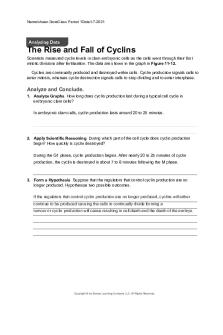Section 1-1 Analyzing Categorical Data PDF

| Title | Section 1-1 Analyzing Categorical Data |
|---|---|
| Author | K-M Smith |
| Course | Statistical Methods I |
| Institution | Clemson University |
| Pages | 3 |
| File Size | 179.8 KB |
| File Type | |
| Total Downloads | 60 |
| Total Views | 158 |
Summary
stat...
Description
1.1 Analyzing Categorical Data A. Definitions 1) Statistics: The science of collecting, describing, and interpreting data. 2) Data: Information about individuals. 3) Individuals: Includes people, animals, and objects. 4) Variables: Any characteristic of an individual. A variable can take different values for different individuals. a) Quantitative Variables: Described with a number in such a way that is makes sense to find an average. Ex. Age, height, weight, heart-rate (pulse), GPA,... (Identification numbers or zip codes are often not quantitative variables.) b) Categorical Variables: Place an individual into one of several categories. Ex. Eye color, hair color, politial affiliation, college major, job type, car make/model, composite material,...
B. Bar graphs and pie charts 1) Used with categorical variables
2) Simple example:
3) Deceptive graphs (textbook examples) a) May use varying area instead of varying heights b) Starting points on vertical axes may not be zero.
C. Two way tables and marginal distributions
1) Ex. College enrollment by major.
a) Marginal distribution row and column totals
(row totals)
b) Conditional distributions Focus on one row or one column. (i) Humanities majors: 100 Freshmen 125 Sophomores 140 Juniors 150 Seniors (ii) Seniors:
200 Sci/Eng. 200 Math/CS Segmented Bar Graphs
330 Social Sci. 150 Humanities
D. Organizing a statistical problem 1) State the problem 2) Plan the techniques which will be used 3) Do. That is, execute the plan. Draw graphs, perform calculations. 4) Conclusions. Summarize results and draw inferences
A frequent goal of statistical studies is to determine association between variables. Association: Specific values of one variable tend to occur in common with values of another variable. Examples: a) Study time and grades b) Smoking and lung cancer c) Exercise and overall health
E. Simpson's Paradox Example In 1990 78% of CEOs in 350 companies were men. In 2010 82.57% of CEOs were men. However, among two classes of companies the percentage of male CEOs dropped. Accounting
Technology...
Similar Free PDFs

Topic 11 Categorical Logic
- 18 Pages

BIO CH13 Analyzing Data
- 1 Pages

BIO CH11 Analyzing Data
- 1 Pages

Section notes 11
- 4 Pages

LAB 3 - Analyzing i OLab Data
- 20 Pages

Chapter 11 - Structured Data
- 4 Pages

Tutorial 11 Data
- 3 Pages

Categorical Logic Outline
- 10 Pages
Popular Institutions
- Tinajero National High School - Annex
- Politeknik Caltex Riau
- Yokohama City University
- SGT University
- University of Al-Qadisiyah
- Divine Word College of Vigan
- Techniek College Rotterdam
- Universidade de Santiago
- Universiti Teknologi MARA Cawangan Johor Kampus Pasir Gudang
- Poltekkes Kemenkes Yogyakarta
- Baguio City National High School
- Colegio san marcos
- preparatoria uno
- Centro de Bachillerato Tecnológico Industrial y de Servicios No. 107
- Dalian Maritime University
- Quang Trung Secondary School
- Colegio Tecnológico en Informática
- Corporación Regional de Educación Superior
- Grupo CEDVA
- Dar Al Uloom University
- Centro de Estudios Preuniversitarios de la Universidad Nacional de Ingeniería
- 上智大学
- Aakash International School, Nuna Majara
- San Felipe Neri Catholic School
- Kang Chiao International School - New Taipei City
- Misamis Occidental National High School
- Institución Educativa Escuela Normal Juan Ladrilleros
- Kolehiyo ng Pantukan
- Batanes State College
- Instituto Continental
- Sekolah Menengah Kejuruan Kesehatan Kaltara (Tarakan)
- Colegio de La Inmaculada Concepcion - Cebu







